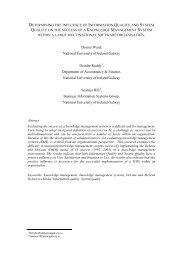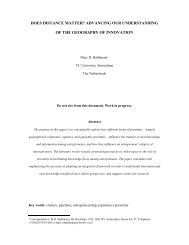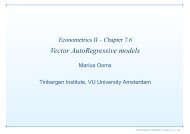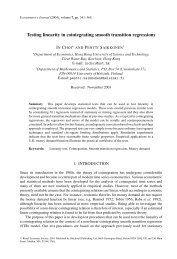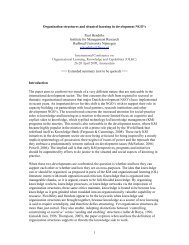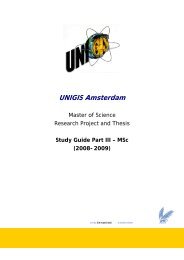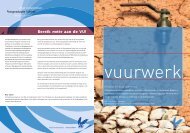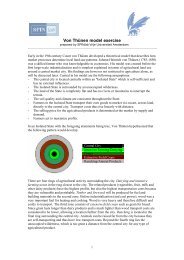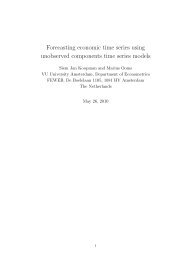The effects of road pricing - Feweb - Vrije Universiteit Amsterdam
The effects of road pricing - Feweb - Vrije Universiteit Amsterdam
The effects of road pricing - Feweb - Vrije Universiteit Amsterdam
Create successful ePaper yourself
Turn your PDF publications into a flip-book with our unique Google optimized e-Paper software.
inhabitants has continuously increased from 1996 to 2001 in every EU-25 country, in<br />
total by 12% (Eurostat, 2004).<br />
Unfortunately, the trend <strong>of</strong> increased <strong>road</strong> travel demand and automobile ownership has<br />
had negative consequences in terms <strong>of</strong> increasing congestion, environmental degradation<br />
and accidents. <strong>The</strong> rate <strong>of</strong> growth <strong>of</strong> car ownership was so fast that the supply <strong>of</strong> new<br />
infrastructure fell behind. <strong>The</strong> capacity <strong>of</strong> the existing <strong>road</strong> infrastructure became too<br />
small, particularly at specific sites during specific times <strong>of</strong> the day. Traffic congestion is<br />
nowadays a recurring ingredient <strong>of</strong> everyday life, making millions <strong>of</strong> car drivers suffer<br />
from significant time losses. Road transport is also one <strong>of</strong> the largest sources <strong>of</strong><br />
environmental pollution in Europe. Environmental impacts associated with car use are<br />
considerable, and concern energy and mineral resources, land resources, air quality<br />
(emissions), noise and health (injuries and deaths from accidents). Estimates <strong>of</strong> these<br />
environmental costs <strong>of</strong> <strong>road</strong> use (excluding vehicle operating costs) amount on average<br />
to some 1.6% <strong>of</strong> GDP in Western Europe, including the external costs <strong>of</strong> accidents<br />
(0.5%), air pollution (0.6%), noise (0.3%) and global warming (0.2%) (UNITE, 2003).<br />
<strong>The</strong> total costs <strong>of</strong> <strong>road</strong> congestion amount to a further 1% according to this study.<br />
Whilst the nature <strong>of</strong> this transport problem differs across regions, the calls for policy<br />
action are intensifying everywhere. Policy makers can choose from a range <strong>of</strong> policy<br />
instruments that deal with different transport externalities. Governments may influence<br />
the achievement <strong>of</strong> a more sustainable transport system by introducing regulations,<br />
imposing taxes, or providing subsidies (e.g. to stimulate the use and development <strong>of</strong><br />
cleaner vehicles). In the present study, the focus is on one specific instrument that is<br />
available to policy makers: transport <strong>pricing</strong>.<br />
1.2 Transport <strong>pricing</strong><br />
Transport economists have <strong>of</strong>ten claimed that price policies should be one <strong>of</strong> the main<br />
pillars <strong>of</strong> transport policy making. <strong>The</strong> idea would be that prices reflecting marginal<br />
costs would induce individuals to behave in a socially beneficial manner, and would thus<br />
lead to an efficiency improvement <strong>of</strong> the transport system, because in the present<br />
transport market prices are generally not optimal. In the competitive model, the<br />
equilibrium price <strong>of</strong> an object will normally equal its cost <strong>of</strong> production (including the<br />
amount needed to pay a firm’s owner to stay in business rather than seek some other<br />
form <strong>of</strong> employment). Elementary economics tells us that, in the long run, price will<br />
then be equated with the marginal (and average) costs <strong>of</strong> each supplier. But the transport<br />
market is different. Simple market economic theory cannot directly be applied to<br />
transport for a variety <strong>of</strong> reasons (see Chapter 2 <strong>of</strong> this thesis). Transport prices do not<br />
simply result from the law <strong>of</strong> supply and demand. Consequently, transport system users<br />
currently do not perceive the full marginal social costs <strong>of</strong> their travel decisions. This<br />
leads to traffic volumes in excess <strong>of</strong> what is socially desirable, and it implies a<br />
suboptimal distribution <strong>of</strong> transport flows over time and space. Economic theory argues<br />
that prices should be corrected, and hence there is a role for governments to intervene in<br />
the market.<br />
Although transport <strong>pricing</strong> seems to have found its way into both Dutch and European<br />
policy documents, the practical reality <strong>of</strong>ten appears quite different from the<br />
economically ideal situation. Governments have <strong>of</strong>ten objectives other than efficiency.<br />
Pricing measures in car transport are in many cases used to raise revenues, or assist in<br />
traffic control, and not so much to reduce congestion or internalise external costs. But<br />
the emerging problems in traffic, such as congestion, call for a possibly more efficient<br />
<strong>pricing</strong> strategy. It is <strong>of</strong> course important to know about the possible <strong>effects</strong> <strong>of</strong> new<br />
2





